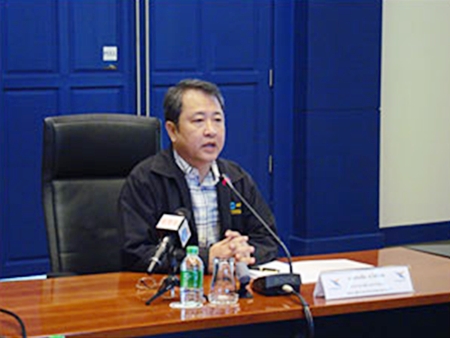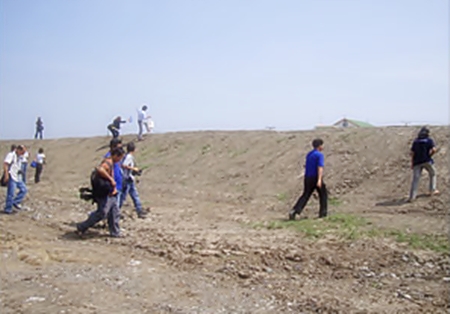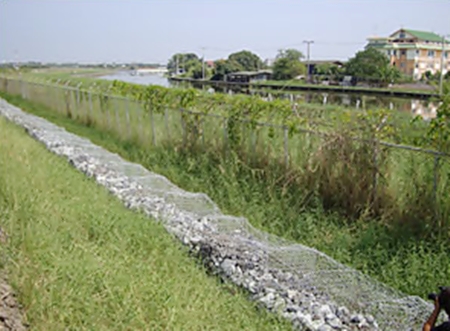Suvarnabhumi Airport is confident of its Flooding Prevention System and is constantly monitoring the water levels.
Mr Somchai Sawasdeepon, Senior Executive Vice President of Airports of Thailand Public Company Limited (AOT) and Acting General Manager of Suvarnabhumi Airport, said Suvarnabhumi Airport is confident of its highly capable Flooding Prevention System in place, with 3.5m high polder dykes surrounding the airport. The construction of the dykes started in 1995 and completed in 2000, which has made them very strong and capable of preventing the penetration of water. Last week, the Department of Highways drilled the dykes to test their strength and has found them to be highly secure and very much capable of preventing water from the outside, if the water level is less than 3.5 meters in height.

Furthermore, Mr Somchai said Suvarnabhumi Airport has a high standard water management system, with drainage canals all around the airport to drain water into the reservoirs, which has capacity to store 4 million cubic meters (m3) of water, and the current level of water in the reservoirs being at 1 million m3 (25%); as well as 2 Pump Stations (4 water pumps in each station) with ability to drain water out at a rate of 12 m3 per second or 1 million m3 per day. Also, the flood prevention dykes surrounding the airport has made the airport into a closed area, whereby water cannot flow in from the outside.

Therefore, the possibility of water leaking through drainage pipes, which has already happen in many places, is extremely remote as the drainage pipes within Suvarnabhumi Airport are not connected to the outside pipes. There are also no issues of traveling to and from the airport as the roads and Airport Rail Link tracks are elevated over the dykes. Mr Somchai added preparations for flooding include 24-hour monitoring of the weather forecast and coordinating with the Royal Department of Irrigation, Bangkok Metropolitan Administration and other relevant agencies. The information received from various agencies is carefully analyzed at all times to best protect the airport. Additionally, a special team of officials has been set up to monitor and protect the barriers surrounding the airport against the flood. Nevertheless, necessary materials and equipments have been prepared in case of emergency needed to fix or strengthen the flood prevention dykes; and recently, engineers from Japan International Cooperation Agency (JICA) inspected the Flood Prevention System and confirmed their confidence in the whole system in place at Suvarnabhumi Airport.

Mr Somchai confirmed all flights and passenger services are operating as usual at Suvarnabhumi Airport; with November, so far, averaging about 100,000 passengers and 900 flights per day. At present, there are already more than 20,000 vehicles parked at Suvarnabhumi Airport, as parking spaces have been opened for flood affected victims; therefore, would advise anyone wishing to travel to the Airport to allow plenty of time and to use public transportation – Airport Rail Link, buses and taxis – and as many roads are affected by the flood, please check for available routes. For further information, please contact Call Center 1722.
FLOOD PROTECTION SYSTEM
Suvarnabhumi Airport is on a flood plain close to mean sea level 0.00 m. and located in the flood way of Bangkok’s eastern suburbs, and therefore requires both effective flood protection and drainage systems. This would have to prevent flooding from flash floods, to drain away rainwater in the airport compound, and also improve the existing drainage system in surrounding areas to prevent flooding in Lad Krabang district and Samut Prakarn province.
This was the premise which led to the study and design of a polder system and drainage canals outside the periphery of the airport connecting with the internal drainage system, and the digging of reservoirs to help collect excess water. A total of four million cubic meters of soil shifted from digging the reservoirs and drainage canals could be used to build the flood prevention dykes, and was therefore a cost-effective method. The design also incorporated a system to control water in the airport compound to a level of -1.25 mean sea level. In addition, it would also be possible to reduce the level of ground water to maintain ground stability especially during the construction period.
In 1993, AOT contracted Thai Engineering Consultants to design a flood prevention system, which was completed in 1994, comprising of:
1. A parallel drainage canal around the project 35 meters wide and 2 meters deep to collect rain water from the runways, taxiways, apron, road surfaces and buildings.
2. Six reservoirs each 2 meters deep, able to hold 3.2 million cubic meters of water, or the equivalent of five consecutive days of rainfall of each five-year cycle without the need for pumping
3. 3.5 meters high polder dykes, 3 meters wide on the top, and 23.5 kilometers in length
4. Two pumping stations to the south of the airport, with a capacity of 6 cubic meters per second. Each station contains 4 pumps, and one reserve pump.
The Flood Prevention System was started in 1995, and completed in 2000. For the latest updates, please visit www.TATnews.org




